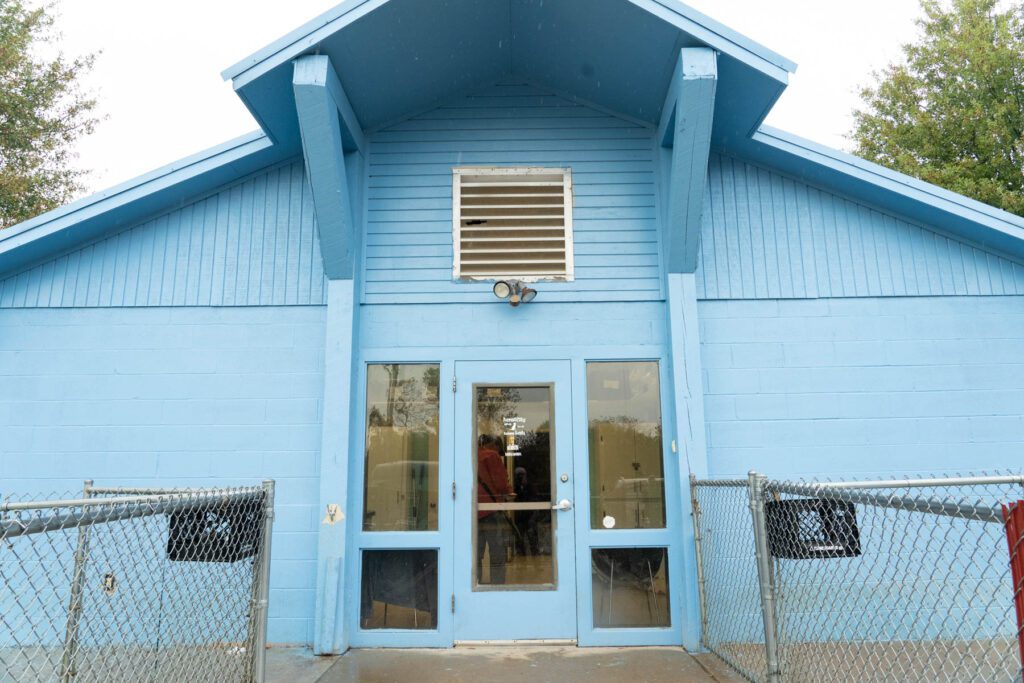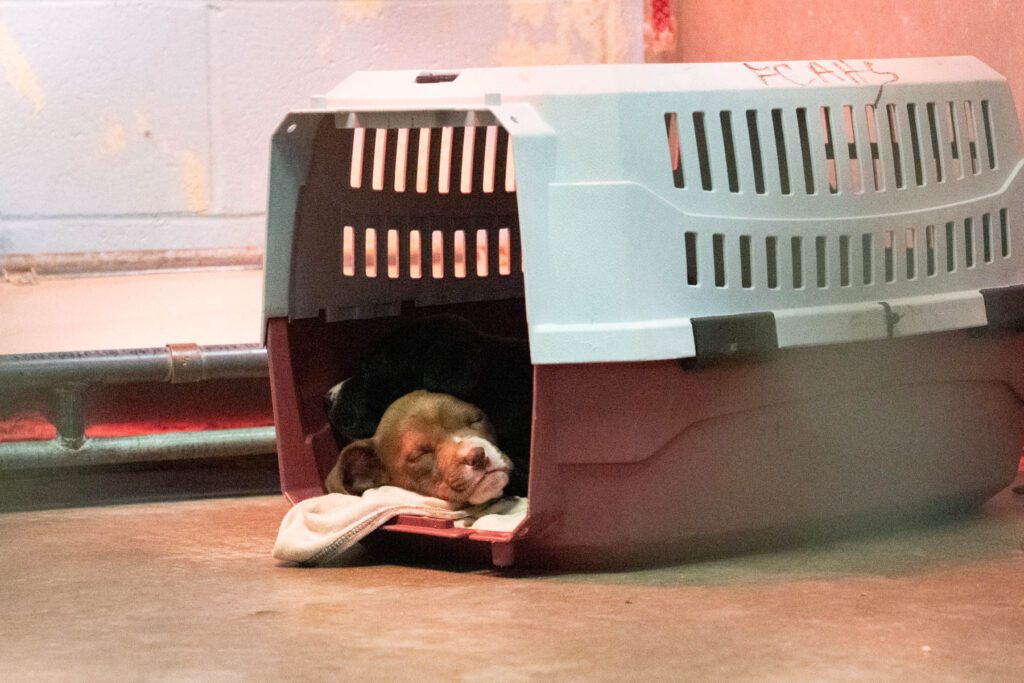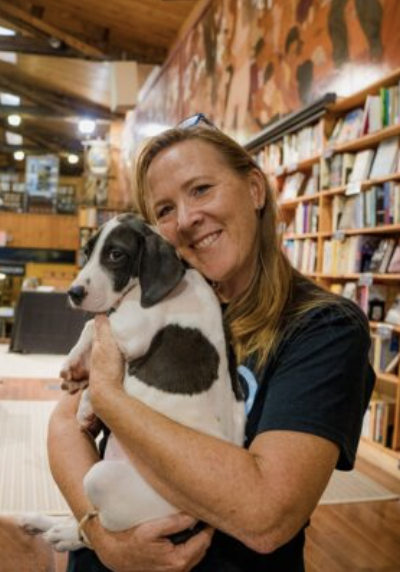It took some doing, but we finally found the Forrest City Area Humane Society which partners with Forrest City Animal Control to save animals. The blue cement building was a mile down a narrow unmarked road that ran beside the train tracks and eventually petered out into a dirt/sand road before arriving at the shelter tucked below Route 1.

Inside, the volunteers of FCHS were hard at work. The city has one ACO officer who handles the morning work, but every day, 365 days a year, this small band of volunteers handles the afternoon chores at the shelter (feeding, cleaning).
They also take care of all the medical work for the dogs (vaccines, deworming, vet appointments, etc.), plus evaluating the dogs, evaluating and documenting the dogs for rescue, and getting the dogs out for exercise and playgroups in the multiple small play yards.
The five remarkable volunteers we met were committed to the work and obviously love the dogs. The fact that they show up day after day to care for these animals, and have been doing so for years, blows me away. Especially, when the stream of dogs never lessens, the stories do not get easier, and they are not able to save every adoptable dog.





There were twenty dogs in the building and ten dogs in foster care the day we visited. The shelter does have to euthanize for space and length of stay. Currently, they save about 80% or more of the dogs they handle, primarily by getting them out through rescue. Like everywhere we go, that is more challenging at this moment in history and they would love to have more rescue partners.
Gay, a long-time volunteer at FCHS, has seen a lot and shook her head as she talked about the attitudes that clearly frustrate her. “They throw them out like a bag of McDonald’s. You wouldn’t believe the stuff we see.” She told us about recent puppies they took in that were being kept in a grocery basket in a front yard.
The shelter handles about 500 dogs a year. Cats, like so many places in the south, are deemed ‘free roaming animals’ and not a responsibility of animal control. They are blessed to have two vets in the area who handle their work, but often have to wait 2-3 weeks for spay or neuter appointments. Both vets are older, one in his early 80s, so they worry about what will happen when they finally retire.










Prior to arriving, Nancy and I had perused the shelter’s beautiful website. It’s really well done, and to be honest, we expected a better situation when we arrived (or at least a sign at the end of their road). We expected that they were saving every adoptable dog, would have a beautiful building, and plenty of money. That was not the case.
And yet, the volunteers we met were amazing, doing so much day after day and clearly, taking great care of their dogs. The dogs were remarkably calm and looked healthy. The building may be older, but the dogs have spacious kennels and all get out to play every day. The city (like the other two shelters we’ve visited in Arkansas) does not provide a budget for food or many essentials, so the Humane Society must raise money or find donations to provide for the dogs.
When we walked through to record a live video, take pictures, and hand out treats, all the dogs came to the front of the kennels to greet us. Surprisingly, there were very few big dogs. Most were medium size, many young, and there were even several very small dogs and a litter of puppies. My immediate thought was—these are easy dogs to move. Even the ‘pocket pitty’, a small blue and white female named Lark, seemed like a dog many rescues would pull.
And yet, as Gay explained, Lark had been here a while and was beginning to deteriorate from the stress of living in the shelter environment. Gay worried that Lark would be one of the 20% they would have to euthanize. Lark’s sweet face stuck with me on the dark, rainy drive to our hotel that night. Just like Max, the big bully dog from our morning visit. They are the reason we continue to travel and walk down row after row of kennels, interview person after person, drive mile after mile.
I believe we can save these animals. I’m sure if the twenty dogs at FCHS were magically teleported to New Jersey or New Hampshire, they would all be adopted easily. But instead, they are in east Arkansas, where a dog’s chances depend on the county lines and the possibility that a group of volunteers is willing to sacrifice their times, energy, and, most likely, personal lives to save them. Too many are forgotten by the citizens of their city or county, and unimportant to the officials who oversee their municipality. As an ACO in another part of the south told us, “Dogs don’t vote.”

In Arkansas, we’ve discovered that the cities have shelters, but the counties do not, and most cities will not accept dogs from the county. On our drive from Forrest City to East Memphis, we saw a stray dog wandering along the highway. We slowed but did not stop because we realized that we were in the county and there was no shelter that would accept the dog. What would we do with him? Nancy pointed out the trailer homes near where he was and we both hoped he belonged at one of them, but his searching face is another one I carried with me as we headed to Tennessee.
We have to do better. We CAN do better. Do you know about the shelter in your city or county? Are the animals safe there? Is there something you could do to make things better for them? And if the animals are safe, does the shelter have room to pull more dogs from places where they are not? Saving these dogs will take all of us.
If you’d like to help Forrest City, consider making a donation through their beautiful website (https://www.fcahumane.org/). A wishlist is posted there, as well as a mailing address. We encouraged them to make an Amazon wishlist and will share it when they do.

Until each one has a home,
Cara
If you want to learn more, be sure to subscribe to this blog. And help us spread the word by sharing this post with others. Visit our website to learn more.
You can also help raise awareness by following/commenting/sharing us on Facebook, Instagram, YouTube, and Tik Tok!
Learn more about what is happening in our southern shelters and rescues in the book, One Hundred Dogs & Counting: One Woman, Ten Thousand Miles, and a Journey Into the Heart of Shelters and Rescues (Pegasus Books, 2020). It’s the story of a challenging foster dog who inspired me to travel south to find out where all the dogs were coming from. It tells the story of how Who Will Let the Dogs Out began. Find it anywhere books are sold. A portion of the proceeds of every book sold go to help unwanted animals in the south.

Watch our Emmy-nominated, award-winning short documentary about rescue in western Tennessee here.
For more information on any of our projects, to talk about rescue in your neck of the woods, please email whowillletthedogsout@gmail.com or carasueachterberg@gmail.com.



Leave a Comment
Sign up for our newsletter
Sign up to have our latest news, grant updates, shelter visits, and more delivered to your inbox.
Share this:
Like this: